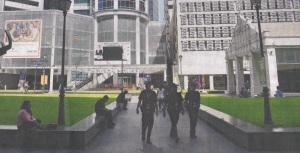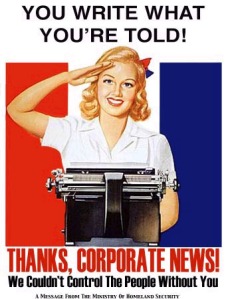As part of our Unit 4 teachings this week, we learnt about agenda setting. Agenda setting refers to the media’s ability, through repeated news coverage, to raise the importance of an issue in the public’s mind. The importance, as perceived in the media, may not be true in reality. Agenda setting doesn’t tell us how to think, but rather what to think about.
We also learnt about priming, which is the process in which the media attend to some issues over others and thereby, alter the standards by which people evaluate the issue.
Examples of agenda setting can be seen in our daily newspapers, such as in The Straits Times, The New Paper, Lianhe Zaobao, etc. For example, in this today’s edition of The Straits Times, the main stories are on sexting, how men are “training” for love, and even Bhutan’s Royal Wedding. We are not told how we should think about this issues, such as whether we agree with the paper’s views or not, but rather, because these issues are brought to our attention, we can now think about them and formulate our own thoughts.
A good example of priming would be the recent Presidential Election, or even the General Elections in May. If you had read the papers during those months, every day’s edition of the news would feature plenty coverage on the presidential/election candidates, their parties, what they stand for, what they have been up to, the issues they raised, any gaffes (if any) made etc. With so much coverage on the elections, the public cannot help but feel that the elections should be at the top of their minds, to be of the highest priority.
The ability of the media to set agenda also depends on several factors such as:
- Obtrusive/unobtrusive issue
- Volume of news coverage on the issue
- Tone of media coverage
- Salience
- Images accompanying the issue
Taking “images accompanying the issue”, take today’s edition of The Sunday Times as an example.
Thousands of people in cities across the globe had take inspiration from America’s “Occupy Wall Street” pretests and were rallying against the corporate greed and government cutbacks. Singapore too had a planned Occupy Raffles Place protest but fell flat after the police intervened and warned the public not to take part in the protest as it was considered unlawful. The picture used, of policemen patrolling an “empty, peaceful” Raffles Place gives Singaporeans something to think about, not just about the protest but also whether we are slowly becoming a totalitarian nation.
So who sets the media agenda? Shoemaker and Reese in 1991 proposed 5 major categories of influence of media content: individual media workers, media routines, media organizations, outside, influence and ideology. They can include editors of magazines, newspapers; media owners, producers, advertisers, political parties, etc.
An example of this would be when WRS cancelled Halloween at the Night Safari. The public was outraged, participants who had helped out were crushed and even the media painted an unflattering light of the woman in the spotlight, Isabella Loh. Newspapers editors could have easily used a picture from the company’s corporate portfolio, etc, but instead, they used a picture that showed her face in a stern expression, unfriendly, someone unapproachable. The agenda has been set; the public then wonders if there is any truth to what people are saying, that Isabella Loh is some sort of an uncaring villain who carried out a silly and thoughtless act by cancelling Halloween at the Night Safari.
Do you think agenda setting in Singapore has been useful, or helpful? Or do you think that agenda setting is another way of the government in controlling our thoughts via mainstream media? Please share!



Our government’s agenda is to prevent any other agenda apart from theirs. 😛
Somehow, I almost knew you were going to say that. 🙂
So you managed to jump the gun on my agenda!
When it comes to the affairs of the nation, the people’s agenda is the government’s agenda; no deviations, no questions asked, and they have good reasons to do so – firstly, protecting the hard earned stability of our nation, and secondly, we cannot afford to do things we’re unprepared for. Take the Qantas protests: Thousands upon thousands of workers ceased operations over a labour row with the company, forcing citizens to be stranded including the Prime Minister. Singapore is a country that depends on the human resource to function. Without people, Singapore will not exist. Should the “Occupy Raffles Place” be successful, what are the repercussions that could happen? I’m not saying that the government is always right but they do things with the citizens in mind. It’s not right to have a workers’ union that has little say in what the workers can and cannot receive. Citizens were upset but this move was proven right when the Union took the lead in the strike in Australia.
The agenda setting function in Singapore is used primarily in areas that citizens can make sound judgement in. The function cannot be used when dealing with issues that can directly change the environment of our country. Hence the need for slanting by the press. While the media can depict some sort of opinion, and “how to think” in their articles, our papers is still large portraying a “what to think about”.
I might be wrong, my brain is not functioning very well now but yeah, this is what I think.
Hi Candice, thanks for your insight! What you brought up does make sense but increasingly, I feel that the government is just being too controlling. It feels like they have made all the decisions already, and are just justifying them now. It’s not even a discussion anymore, but more of a “Okay, so we’re doing this and here’s why. We don’t care if you like it or not, because we’re already doing it”.. Wonder if you feel the same way?
Singapore’s media to a certain extent act as neutral medium for conveying news, reporting fully and fairly what goes on, thus it is quite useful and informative… And I do agree with Candice that the mainstream media is telling us “what to think about” rather than “how to think”.
Hi Youyi, thanks for your insight!! 😀